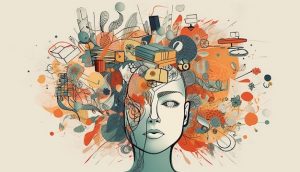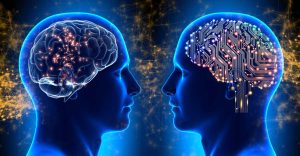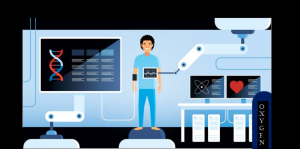Introduction
Generative artificial intelligence, often called GenAI, is at the vanguard of the AI revolution, enabling robots’ limitless creative and problem-solving potential. GenAI represents a crucial fusion of cutting-edge technology and human creativity in a world where artificial intelligence continuously pushes the bounds of what is possible. This new area of AI goes beyond simple prediction and is classified by using machines to produce content, data, and solutions that closely mimic human information. In this article, we explore the significant influence of GenAI, from its underlying ideas to its practical applications and complex implementation, as we explore the worlds of art, medicine, business, transportation, gaming, and more. This in-depth study will examine how generative AI is reshaping everything around us. We’ll give you a deep understanding of GenAI’s capabilities and inspire you with examples of practical applications.

Learning Objectives
You will have gained an understanding of the base of generative AI after reading this article.
- Find out how to use generative AI in practice to significant effect.
- Learn more about how these use cases employ generative AI.
- Learn more about the possibility of generative AI technology in the future.
This article was published as a part of the Data Science Blogathon.
Table of contents
Understanding Generative AI
A family of artificial intelligence models and algorithms, known as “Generative AI,” can produce data, material, or other outputs strikingly comparable to data humans have produced. Producing text, music, graphics, and even more complicated outputs like software code or academic research articles are all included in this.
What is Generative AI?
Generative AI, sometimes known as “artificial intelligence that creates new content, data, or solutions,” is a cutting-edge subfield of artificial intelligence. Generative AI uses the strength of deep learning algorithms to produce results that closely resemble human data, in contrast to typical AI models that focus largely on analysis and prediction.
These cutting-edge models, such as Variational Autoencoders (VAEs) and Generative Adversarial Networks (GANs), have the capacity to grasp complex data distributions and provide unique, contextually relevant information, making them invaluable across a huge range of applications.

Use Cases of Generative AI
Now, let’s dig deeper to understand the several use cases of generative AI and how it reshapes everything around us.
Art and Creativity
With the ability of machines to create music and art, generative AI has ignited a creative revolution. Musicians and artists are using these models to experiment with new modes of expression. Deep learning is used, for instance, by the AIVA (Artificial Intelligence Virtual Artist) music composition system to create unique works of classical music that are on par with those created by human musicians.

Natural Language Processing (NLP)

Generative AI models have led the way for chatbots and text production improvements in Natural Language Processing. The OpenAI-developed GPT-3 (Generative Pre-trained Transformer 3) has displayed impressive language recognition and generation abilities. It can hold meaningful discussions, translate between languages, and even write articles like this one.
Healthcare

By assisting in medication discovery, medical imaging analysis, and individualized treatment regimens, generative AI is revolutionizing healthcare. One famous application is DeepMind’s AlphaFold, which utilizes deep learning to forecast the 3D architectures of proteins. This discovery could quicken the process of developing new drugs and advance our knowledge of disease.
Finance
Through algorithmic trading, risk analysis, and fraud detection, generative AI helps the financial sector. AI-powered trading bots make real-time market data analysis and trading decisions, while Generative AI models may produce accurate financial reports and forecasts that aid investors and analysts in making wise choices.

Automotive Industry
A great example of generative AI in action is autonomous automobiles. These cars use Deep learning algorithms to interpret sensor data, make driving judgments, and even forecast pedestrian activity. Generative AI also simulates and designs vehicle parts, simplifying the auto design process.
Gaming and Entertainment
Generative AI improves the player experience in the gaming and entertainment sectors. Procedural generating techniques are used in games like No Man’s Sky to build expansive, varied game settings. Characters controlled by AI can also change and react to player actions, resulting in engaging and dynamic gameplay.

After examining various application cases, let’s examine how you can use generative AI in these situations.
What are the Implementations of Generative AI?
The implementation of Generative AI involves several stages, including data collection and preparation, model selection and training, evaluation and fine-tuning, and deployment and integration. Here’s a detailed breakdown of the implementation process:
Data Collection and Preparation
Data preparation and gathering are the first steps in implementing generative AI. For models to be trained successfully, high-quality datasets are necessary. A dataset of well-known artworks may be employed in the art-generating scenario. Massive text corpora are gathered for NLP tasks.
import numpy as np
from keras.datasets import mnist # Load the MNIST dataset
(X_train, _), (_, _) = mnist.load_data() # Normalize the data between -1 and 1
X_train = X_train / 127.5 - 1.0
X_train = np.expand_dims(X_train, axis=3)
Model Selection and Training
The Generative AI model that is selected relies on the particular use case. While GANs are appropriate for creating images, models like GPT-3 are frequently used to create text. During training, the model is fed with the data, and its parameters are to produce the desired output quality.
Model selection and training represent a basic changing point in the GenAI field, where artificial intelligence’s revolutionary potential begins to take shape. A suitable GenAI model is selected after a detailed investigation of the problem and its particular needs occurs in the first step of the process.
from keras.models import Sequential, Model
from keras.layers import Dense, Flatten, Reshape
from keras.layers import Conv2D, Conv2DTranspose
from keras.layers import LeakyReLU, Input
from keras.optimizers import Adam # Generator model
def build_generator(): model = Sequential() model.add(Dense(128, input_shape=(100,))) model.add(LeakyReLU(alpha=0.2)) model.add(Dense(784, activation='tanh')) model.add(Reshape((28, 28, 1))) return model # Discriminator model
def build_discriminator(): model = Sequential() model.add(Flatten(input_shape=(28, 28, 1))) model.add(Dense(128)) model.add(LeakyReLU(alpha=0.2)) model.add(Dense(1, activation='sigmoid')) return model # Combined GAN model
def build_gan(generator, discriminator): discriminator.trainable = False gan_input = Input(shape=(100,)) x = generator(gan_input) gan_output = discriminator(x) gan = Model(gan_input, gan_output) gan.compile(loss='binary_crossentropy', optimizer=Adam(0.0002, 0.5)) return gan # Build and compile the models
generator = build_generator()
discriminator = build_discriminator()
gan = build_gan(generator, discriminator)
Selecting the suitable model is important for using Generative Adversarial Networks (GANs) or subtle text generation using models like GPT-3. After selection, the model initiates a training phase to learn the intricacies present in the data.
During this process, it consumes and processes massive datasets. The model’s parameters are readjusted during training to improve its detailed generating ability. During this phase, the model continuously enhances its output to conform to the intended quality and relevance, equal to the model growing its creative or problem-solving skills.
def train_gan(epochs, batch_size): for epoch in range(epochs): for _ in range(X_train.shape[0] // batch_size): noise = np.random.normal(0, 1, (batch_size, 100)) generated_images = generator.predict(noise) real_images = X_train[np.random.randint(0, X_train.shape[0], batch_size)] labels_real = np.ones((batch_size, 1)) labels_fake = np.zeros((batch_size, 1)) # Train the discriminator d_loss_real = discriminator.train_on_batch(real_images, labels_real) d_loss_fake = discriminator.train_on_batch(generated_images, labels_fake) d_loss = 0.5 * np.add(d_loss_real, d_loss_fake) # Train the generator noise = np.random.normal(0, 1, (batch_size, 100)) labels_gan = np.ones((batch_size, 1)) g_loss = gan.train_on_batch(noise, labels_gan) # Print progress print(f'Epoch: {epoch+1}, D Loss: {d_loss[0]}, G Loss: {g_loss}') # Save generated images at specified intervals if epoch % save_interval == 0: save_generated_images(epoch) # Function to save generated images
def save_generated_images(epoch, examples=10, dim=(1, 10), figsize=(10, 1)): noise = np.random.normal(0, 1, (examples, 100)) generated_images = generator.predict(noise) plt.figure(figsize=figsize) for i in range(examples): plt.subplot(dim[0], dim[1], i + 1) plt.imshow(generated_images[i], interpolation='nearest', cmap='gray') plt.axis('off') plt.tight_layout() plt.savefig(f'gan_generated_image_epoch_{epoch}.png') # Train the GAN
train_gan(epochs=30000, batch_size=64, save_interval=1000)
The GenAI system’s final skill in model selection and training depends on selecting the model architecture, the quantity and quality of training data, and the optimization methodology.
Evaluation and Fine-tuning
The model needs to undergo a thorough evaluation after training. This may involve evaluating the aesthetic quality of artificially created works of art. The evaluation of NLP models considers the content’s coherence and relevance.
To ensure their effectiveness, GenAI models must go through necessary rounds of evaluation and fine-tuning. After training, a model is thoroughly assessed to establish its efficacy and applicability for the hand task.
# Function to evaluate the model performance
def evaluate_model(epoch, generator, discriminator, examples=10, dim=(1, 10), figsize=(10, 1)): noise = np.random.normal(0, 1, (examples, 100)) generated_images = generator.predict(noise) real_images = X_train[np.random.randint(0, X_train.shape[0], examples)] # Plotting generated images plt.figure(figsize=figsize) for i in range(examples): plt.subplot(dim[0], dim[1], i + 1) plt.imshow(generated_images[i], interpolation='nearest', cmap='gray') plt.axis('off') plt.tight_layout() plt.savefig(f'gan_generated_image_epoch_{epoch}.png') # Discriminator loss on real and fake images d_loss_real = discriminator.evaluate(real_images, np.ones((examples, 1)), verbose=0) d_loss_fake = discriminator.evaluate(generated_images, np.zeros((examples, 1)), verbose=0) # Generator loss g_loss = gan.evaluate(noise, np.ones((examples, 1)), verbose=0) print(f'Epoch: {epoch+1}, D Loss Real: {d_loss_real[0]}, D Loss Fake: {d_loss_fake[0]}, G Loss: {g_loss}')
Fine-tuning a GAN involves modifying the model architecture, hyperparameters, or training strategy based on the evaluation results. Fine-tuning is a critical step to improve the GAN’s performance. Below is a generic example of how to do a fine-tuning process:
# Function for fine-tuning the GAN
def fine_tune_gan(generator, discriminator, gan, fine_tuning_epochs=1000, fine_tuning_batch_size=64): for epoch in range(fine_tuning_epochs): # Fine-tuning process (modify as needed) # Example: Train the discriminator for a few extra steps for _ in range(5): real_images = X_train[np.random.randint(0, X_train.shape[0], fine_tuning_batch_size)] labels_real = np.ones((fine_tuning_batch_size, 1)) d_loss_real = discriminator.train_on_batch(real_images, labels_real) noise = np.random.normal(0, 1, (fine_tuning_batch_size, 100)) generated_images = generator.predict(noise) labels_fake = np.zeros((fine_tuning_batch_size, 1)) d_loss_fake = discriminator.train_on_batch(generated_images, labels_fake) # Train the generator noise = np.random.normal(0, 1, (fine_tuning_batch_size, 100)) labels_gan = np.ones((fine_tuning_batch_size, 1)) g_loss = gan.train_on_batch(noise, labels_gan) # Print progress print(f'Fine-tuning Epoch: {epoch+1}, D Loss Real: {d_loss_real[0]}, D Loss Fake: {d_loss_fake[0]}, G Loss: {g_loss}')
Deployment and Integration
After successful training and assessment, deploy the Generative AI model. It can integrate into various applications, such as chatbots, art creation software, and driverless vehicles, requiring real-time functionality and smooth integration.
The selection of the appropriate GenAI model, Generative Adversarial Networks (GANs) for image generation or GPT-3 for natural language processing challenges, is a vital next step. To achieve the desired output quality, one must train these models by feeding them data and adjusting their parameters. Following this iterative process, experts extensively analyze the GenAI model to ensure it meets the desired results.
Deploying and integrating a generative AI model involves preparing the model for deployment and integrating it into applications or systems. Below is a generic example of how to deployment and integration process:
# Function to prepare the model for deployment
def prepare_for_deployment(generator): # Save the generator model to a file for future use generator.save('generator_model.h5') # Function to integrate the model into an application
def integrate_into_application(input_noise): # Load the generator model generator = load_model('generator_model.h5') # Generate an image using the provided input noise generated_image = generator.predict(input_noise) # Display or use the generated image in the application plt.imshow(generated_image[0], cmap='gray') plt.axis('off') plt.show() # Example usage of preparing for deployment
prepare_for_deployment(generator) # Example usage of integrating into an application
input_noise = np.random.normal(0, 1, (1, 100)) # Random input noise for image generation
integrate_into_application(input_noise)
Ethical Considerations
- Generative AI implementers must consider ethical issues when working with sensitive data or potentially biased outcomes.
- Adherence to data privacy regulations is essential in the use of Generative AI.
- GenAI’s revolutionary potential raises complex ethical questions and responsibilities.
- Concerns regarding potential abuse and deception grow as GenAI models improve content generation.
- Addressing bias in training data is crucial to avoid the propagation of social preconceptions.
- Measures for fairness and transparency in model outputs are necessary.
- GenAI’s use in generating realistic personal data highlights privacy issues and the need for stringent data protection.
- Accountability for potential copyright or ethical violations in GenAI-generated content is a concern.
- Balancing GenAI’s revolutionary potential with ethical concerns requires the development of regulations and moral norms.
- GenAI is revolutionizing industries and enhancing creativity for both machines and humans.
Conclusion
In conclusion, the world of GenAI is a changing space with limitless possibilities and game-changing potential. Some important insights emerge by examining its base, real applications, ethical issues, and obstacles. GenAI is a changing point in the development of artificial intelligence because it makes robots not only to predict but also to make, invent, and solve complex problems in many fields. Its impact ranges from revitalizing art and music to revolutionizing finance, healthcare, gaming, and more. Summarizing the key insights and aspects discussed in the text about Generative AI (GenAI):
- GenAI extends beyond prediction, enabling machines to create, innovate, and solve complex problems across diverse fields.
- Ethical aspects encompass bias reduction, data protection, and prevention of content exploitation.
- Ethical considerations are at the core of GenAI implementation, necessitating responsible handling of biases, data, and generated content.
- GenAI promises to revolutionize industries, foster creativity, and redefine human-machine collaboration.
- Future progress hinges on ethical standards, fair resource distribution, and collaborative scientific efforts.
It is changing several areas, including healthcare and the arts. Data preparation, model training, evaluation, deployment, and ethical issues are all part of implementing generative AI.
Frequently Asked Questions
A: Generative AI, often called GenAI, is a subset of artificial intelligence (AI) that involves creating models capable of producing data, material, or outputs resembling human-generated content. This includes generating text, music, images, and more using advanced algorithms and deep learning.
A: Generative AI goes beyond conventional AI, mainly focusing on analysis and prediction. It involves machines actively creating content or data that closely resembles human-generated information. This sets it apart and opens creative and problem-solving possibilities in various domains.
A: The main types of Generative AI models include Generative Adversarial Networks (GANs), Variational Autoencoders (VAEs), and Recurrent Neural Networks (RNNs). Two competing networks generate high-quality data in GANs, probabilistic models for data generation are what VAEs are, and text generation often involves using RNNs.
A: Generative AI finds applications in art and creativity (music, art), natural language processing (chatbots, content creation), healthcare (medication discovery, medical imaging analysis), finance (algorithmic trading, risk analysis), and the automotive industry (autonomous vehicles, vehicle part design), among others.
A: Challenges with Generative AI include biases in training data, high energy consumption during training, potential misuse for creating harmful content, and limitations in contextual understanding. Ethical considerations include ensuring fairness, transparency, data privacy, and responsible use to prevent misuse and uphold ethical standards.
The media shown in this article is not owned by Analytics Vidhya and is used at the Author’s discretion.
Related
- SEO Powered Content & PR Distribution. Get Amplified Today.
- PlatoData.Network Vertical Generative Ai. Empower Yourself. Access Here.
- PlatoAiStream. Web3 Intelligence. Knowledge Amplified. Access Here.
- PlatoESG. Carbon, CleanTech, Energy, Environment, Solar, Waste Management. Access Here.
- PlatoHealth. Biotech and Clinical Trials Intelligence. Access Here.
- Source: https://www.analyticsvidhya.com/blog/2023/10/how-generative-ai-is-reshaping-business-healthcare-and-the-arts/



